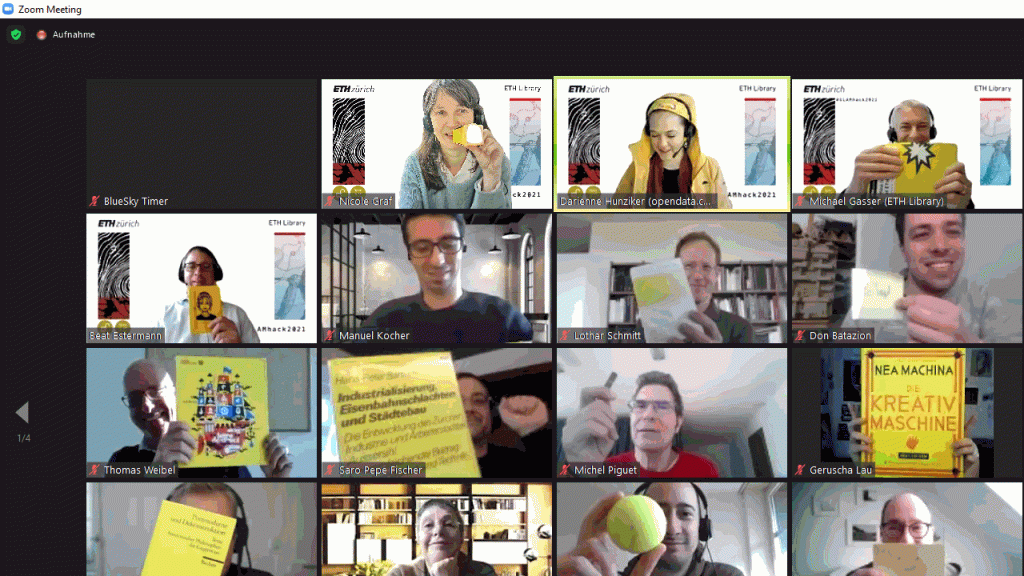GLAMhack 2021 – Creative and Fun Hacking
The 7th edition of the Swiss Open Cultural Data Hackathon, carried out as an online event and organized with the help of the ETHZ Library, took place from April 16th to 17th. Over the span of two days, 17 new projects using cultural data were created. With about 75 active participants, the online event was a full success.
While we were sad that this year’s GLAMhack once again couldn’t be in person, the excitement of the GLAM community about the yearly Hackathon remained undeterred. The mood, atmosphere, and collaborative spirit surpassed our (already high) expectations. It was great to see many familiar faces from past hackathons and many new ones. The results of this year’s hackathon are presented below:
helvetiX: An XR guide to Helvetia aims at providing an immersive Virtual Reality guide for any Roman merchant or legionary when travelling to ancient Helvetia. (In Latin, of course.) The project is based on the Peutinger Map, an illustrated itinerarium (ancient Roman road map) showing the layout of the cursus publicus, the road network of the Roman Empire.
The Collection Chatbot: Silverfish is an interactive chatbot which guides you through the collection of the Stiftung für Kunst, Kultur und Geschichte (Foundation for Art, Culture and History) and recommends objects based on user input. This creates a narration-driven experience of the collection. You can try the prototype on Telegram: https://t.me/SilverFishGlamBot
Another project dealt with The spatial evolvement of a Museums’ collection. The project maps the places of origins of the Museum der Kulturen Basel’s collection and thus gives an overview of the collecting habits of the museum over the past 121 years: https://hackathon21.netlify.app/
A walk through Zurich around 1910 lets you experience a stroll along Langstrasse based on the pictures of photographer Friedrich Ruef-Hirt (1873-1927). You can watch the video of the stroll online.
1971 and all that – Women’s Right to Vote in Switzerland analyzed relevant newspaper articles to see how the discourse around women’s suffrage changed over time.
Deploy Looted-Art Detector is an evolution of the Looted-Art Detector created at GLAMhack 2020 which helps find looted art in art collections. You can try it out here: https://artdata.pythonanywhere.com
Another project from last year which was further developed was Culture In-Time 2. Using linked open data the project lets you discover past and future events.
The team around Nachtschicht 21 a 3D, Virtual Reality & Art Exhibition created a VR space with contemporary artworks by young swiss artists to accompany the gallery exhibition.
Wikidata Tutorial Factory is a website featuring Wikidata tutorials for heritage institutions. During the hackathon several tutorial scripts as well as tutorials in four languages were created.
Another project working with Wikidata and other Wiki projects was the WikiCommons metadata analysis tool which compares the metadata of the source system of a GLAM institution (e. g. E-Pics Image Archive Online) and Wikimedia Commons and lists the differences.
Archived-Data-Driver helps understand data by creating a tool that could run on open data providers’ servers, but also on a local computer, which automatically generates an overview of the files, images and along with some summary statistics.
The Pellaton Experience is a project to map over sixteen hours of interviews with dance historian Ursula Pelleton in a non-linear way and to enrich it with supplementary information.
The St. Galler Globus is another project that wants to enrich existing material with digital solutions to make the Globus’ narratives and historical context accessible to a broader audience interested in “Scientainment”.
By Making digitised scores audible, one project made digital scores available in e-rara and other databases more accessible by creating audio files to not only read them, but also listen to them.
Another project using e-rara worked on making formulas in old scientific titles more readable and searchable. e-rara: Recognizing mathematical Formulas and Tables helps OCR (optical character recognition) to also transcribe the formulas.
heARTful – Art & Emotions lets people judge the emotions of people portrayed in paintings. The project also lets you see how other people judge the painting and gives additional information about the paintings and their authors.
The scene lives! The demoscene that is. An open dataset of demoscene production was created to showcase demoscene works from the beginning to current times.
These projects are at various stages of development, ranging from sketches to fully-fledged prototypes; we are curious to learn about their future development and are looking forward to next year’s GLAMhack.




